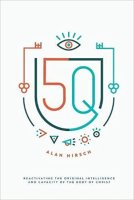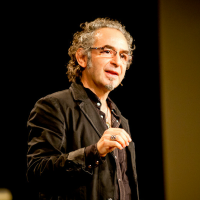 5Q: Reactivating the Original Intelligence and Capacity of the Body of Christ by Alan Hirsch. 100M (April 2017, 216 pp).
5Q: Reactivating the Original Intelligence and Capacity of the Body of Christ by Alan Hirsch. 100M (April 2017, 216 pp).
Confession: I am an Alan Hirsch fan. This is the second of his books that I’ve reviewed and the fourth that I’ve read, following in the footsteps of The Forgotten Ways, The Permanent Revolution (with Tim Catchim), and Untamed (with Debra Hirsch). I have also had the pleasure of hearing him speak at a few different conferences and I find him to be an enjoyable and stimulating speaker and thinker. He is undoubtedly brilliant and has spent years studying social and spiritual movements to unearth wisdom and insight for the Church today.
Probably his most significant contribution to the missional conversation for the past 10-15 years has been to recenter the Fivefold giftings (Apostle, Prophet, Evangelist, Shepherd, Teacher – collectively known as APEST) found in Ephesians 4 and give church leaders handholds for incorporating these giftings into the practices and organizational systems of their churches. If you have heard the term “apostolic” thrown around by a pastor or church leader in your circle, I would wager that they have been influenced by Hirsch or someone from his various tribes (Forge, 100 Movements, etc.). His books have offered me great personal encouragement and rebuke as I wrestle with some of my own hangups as a church member and ministry leader and I have used his tools and insights to train others as well.
That being said, my primary critique with any Alan Hirsch book is that they are normally 25-30% longer than they need to be. Alan is a framework thinker and paradigm shifter and he seems to find it irresistible to make sure the reader sees as many threads of connectivity as possible between his new paradigm and the worlds of sociology, art, history, and, in this book, even in the patterns of creation itself.
The first sixty pages of this book are pretty tedious both in the retreading of other material from his previous books (some of which, admittedly, is probably helpful to a new Hirsch reader) and in the amount of time spent at the 10,000 foot view without ever getting to even a single anecdote or practical application. I can very easily imagine a 150 page version of this book that would be equally if not more effective. As a practical example (so as not to be hypocritical), I am a heavy outliner when I read but I outlined only one memorable concept for the first 77 pages of this book and it was a block quote from another book.
The Good & The Quotable:

Alan Hirsch, author of 5Q
A stronger editing hand notwithstanding, the core theme of this book is a sharp and necessary challenge to the Church in our time. With 5Q, Hirsch is making the central argument that the fivefold giftings are essentially archetypes that have been hardwired into creation and fully embodied in the life, ministry, and teachings of Jesus. Given then that the Church is to be the embodiment of Christ (“the fullness of him who fills everything in every way” – from Ephesians 1), any local church should be marked by the full manifestation of these five callings.
It may sound simple but this “If A, then B and if B, then C” style of argument is actually pretty revolutionary, particularly in Western evangelical culture which is constantly wringing its hands over what the “marks” of a true church should be, particularly over and against parachurch models and fear regarding theological/doctrinal error. Into this conversation, which sadly often devolves into power-grabbing and scarcity outlooks on ministry, Hirsch injects a much-needed and well-developed paradigm shift.
I say “shift,” but like all great missional “innovations,” its biggest strength is in its ability to “shift” us back to our centerpoint of the life of Jesus as revealed in the Scriptures. Hirsch is essentially saying that you can identify a “church” by the degree to which any community embodies the five central functions of Jesus’ own ministry. Like IQ or EQ which seek to describe an individual’s intellectual or emotional capacities, Hirsch imagines 5Q as a paradigm by which to measure and describe a given church’s capacity to image and embody Christ’s continued ministry in the world.
If this material were to be taken up, studied, and applied by a local community, I can certainly imagine some dramatic and helpful changes occurring that would likely lead to at least a broader recognition of giftedness in the community and a balancing away from certain gifts that tend to be more celebrated, like Teaching. Though there are a few helpful assessment prompts and visuals, the book stops just short of practical while pointing the reader to a workbook that can also be purchased separately for those wishing to implement the material (a common theme with Hirsch’s books) and a website that has a few free resources, options to pursue deeper consulting and paid assessment tools, and promises of more to come. For my own personal benefit, I would have loved even a handful of brief anecdotes of churches and organizations that have used 5Q successfully but they were sadly absent from this book.
As always, here are a few of my favorite quotes to give you a taste of the material:
“He [Jesus] is not some detached lecturer. He is himself ‘the Way,’ and he shows us what a lifestyle based on truth looks like (John 1:17, 14:6). In Jesus, ethics becomes ethos – a way to live. He discipled his followers by actually living life with them – he was their Master and Rabbi, and they lived under his word and authority.” (77)
“The church carries out the work that Jesus started and it does it in a way that is consistent with who Jesus was and how he went about his own ministry.” (80)
“We do not merely represent Jesus – in some real way we are meant to actually embody/incarnate him.” (81)
“By insisting on the priesthood of all believers the Reformation rejected the ‘priestcraft’ of Catholic sacramentalist tradition only to create another form of Protestant clericalism and religious sacramentalism every bit as elitist and entrenched as the Catholic ones.” (131)
“The organizational bias of the inherited form of church organization is in a real sense a reflection of the consciousness of the people who designed it in the first place.” (131)
“Where the marks are recognizably present i.e., the defining presence on Jesus, missional impact, covenant faithfulness, gospel proclamation, reconciled community, and deep wisdom – there you have a real authentic church.” (135)
 The Transferable:
The Transferable:
Again, I want to reiterate that this book is primarily the communication of a paradigm by which to conceptualize the Church. There are very few stories and even fewer tools, per se, given that could be immediately used in a practical sense. That being said, there is a helpful diagnostic exercise (p. 140) that Hirsch encourages the reader to use to “score” their community’s 5Q from 0-5 in each of the five functions. The scoring is done on a concentric pentagon (see image) with each point representing one of five such that you’re left with a visual representation of your community’s 5Q. Combined with a robust communal understanding of the five gifts, I think this diagnostic could be a powerful tool for assessment and strategic planning for leaders to use as they consider their community’s strengths and shore up its weaknesses.
Who Should Read This:
This is a book for leaders who enjoy conceptual/framework thinking, don’t need a lot of practical handholds in order to implement what they read, and are looking for a fresh take on injecting APEST-style leadership into their community wholesale. If you’re new to Hirsch/APEST, I would actually recommend starting with The Forgotten Ways, which for me is his most practical work, and then decide if you want to keep going from there. The middle ⅓ of this book is wonderful and a great jumping off point from TFW but the first and last ⅓ are pretty tough if you don’t enjoy Hirsch’s communication style.